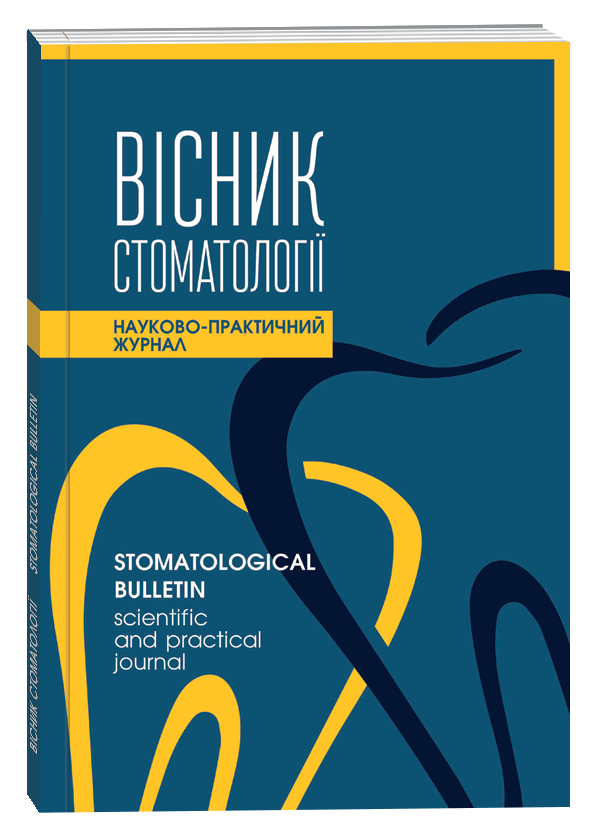THE JUSTIFICATION FOR THE USE OF TEMPORARY DENTAL IMPLANTS AS A SKELETAL SUPPORT DURING ORTODONTIC TREATMENT OF PATIENTS WITH SECONDARY DEFORMATIONS OF DENTAL ROWS
DOI:
https://doi.org/10.35220/2078-8916-2019-33-3-29-34Keywords:
orthodontic mini-implant, temporary dental implant, secondary deformations of dental rowsAbstract
Purpose of research. The use of dental implants as an anchorage for orthodontic treatment causes the highest stresses in the bone tissue with a horizontal load com-pared to a vertical one. It is the horizontal load that can cause mobility and disintegration of the implant, cause resorption or necrosis of the bone around the implant. In the case of using a dental implant only for orthodontic treatment, it is better to use a one-stage technique. Then the implant can be loaded immediately after its installa-tion, invasive procedures are reduced and aesthetic re-quirements are not taken into account.
Materials and methods. Since the intraosseous design and characteristics of OMG orthodontic mini-implants and VKtemp temporary dental implants are comparable, and the biomechanical characteristics of the bone-implant model should not differ significantly, in this re-gard, studies of the mechanical endurance of bones and implants under power load were carried out. There were 4 stages of experimental research: installation of implants at an angle of 15-20 degrees and 90 degrees to the plane of the body of the pig’s rib and 1 kilogram-force (kgf) (9.8 N) and 2 kilogram-force (19.6 N) were used with horizon-tal and vertical load. 2 weeks after application of the load, visual inspection of the ribs (examination was car-ried out under an increase of 2.5 and 3.5 times) revealed no changes in the bone around the implants.
Summary. The implants did not change their initial posi-tion, were motionless and stable. A comparative analysis of x-ray images of the bone tissue of the investigated rib samples made before and after loading did not reveal any morphological changes in the bone around the implants.
References
Рівіс О. Ю. Застосування скелетної опори на міні-імплантати при лікуванні зубощелепних аномалій (огляд лі-тератури) / О. Ю. Рівіс, А. М. Потапчук // Вісник стомато-логії. – 2013. – №3(84). – С. -102.
Бабов Е. Д. Сравнение функционирования микро-имплантов и минипластин для временного скелетного анко-ража на протяжении ортодонтического лечения / Е. Д. Ба-бов, Т. Б. Херсонская, Н. А. Борченко // Современная орто-донтия. – 2015. – № (39). – С. 22-23.
Куцевляк В. И. Аппаратурно-хирургическое ле-чение пациентов с аномалийным положением зубов в по-стоянном прикусе / В. И. Куцевляк, Ю. Г. Данилова // Актуальні проблеми сучасної медицини. – 2015. – Т. . – № 3 ( ). – С. 22-28. 4. Gautam P. Implants for anchorage. / P. Gautam, A. Valiathan // Am J Orthod Dentofacial Orthop. – 2006. – №2 (129). – Р. 174.
Moon C. Factors associated with the success rate of orthodontic miniscrews placed in the upper and lower posterior buccal region / C. Moon // Angle Orthodontist. – 2008. – V. 78. – P. 101-106. 6. Reynders R. Mini-implants in orthodontics: a systematic review of the literature / R. Reynders, L. Ronchi, S. Bipat // Am J Orthod Dentofacial Orthop. – 2009. – № ( 3 ). – Р. 64.e -19.
Nienkemper M. Mini-implant stability at the initial healing period: a clinical pilot study / M. Nienkemper, B. Wilmes, A. Pauls, D. Drescher // Angle Orthodontist. – 2014. – Vol. 84(1). – P. 127-133. 8. Garg K.K. Assessment of stability of orthodontic mini-implants under orthodontic loading: A computed tomography study / K.K. Garg, M. Gupta // Indian J Dent Res. – 2015. – №3 (26). – Р. 237-43.
Failure of Orthodontic Mini-implants by Patient Age, Sex, and Arch; Number of Primary Insertions; and Frequency of Reinsertions After Failure: An Analysis of the Implant Failure Rate and Patient Failure Rate / J.W. Kim, N.K. Lee, H.Y. Sim [et al.] // Int J Periodontics Restorative Dent. – 2016. – №4 (36). – Р. 9-65. 10. Huang L.H. Dental implants for orthodontic anchorage / L.H. Huang, J.L. Shotwell, H.L. Wang // Am J Orthod Dentofacial Orthop. – 2005. – №6( 27). – Р. 713-22.
Numerical/experimental analysis of the stress field around miniscrews for orthodontic anchorage / A. Gracco, A. Cirignaco, M. Cozzani [et al.] // European Journal of Orthodon-tics. – 2009. – V. 31. – P. 12–20.
Factors affecting stresses in cortical bone around miniscrew implants. A three-dimensional finite element study / R. Duaibis, B. Kusnoto, R. Natarajan [et al.] // Angle Orthodon-tist. – 2012. – V. 82. – P. 875 – 880.
Carano A. Clinical applications of the Mini-Screw-Anchorage-System (M.A.S.) in the maxillary alveolar bone / A. Carano, S. Velo, C. Incorvati // Prog Orthod. – 2004. – V. 5. – P. 212-235. 14. Патент на корисну модель № 8 222, Україна, МПК (2 3. ) А6 С 8/ . Ортодонтичний імплантат / Міщенко О. М., Рівіс О. Ю. – № u 2 3 6936; Заяв. 3. 6.2 3; опубл. . .2 3 – Бюл. № 2 .
Рівіс О. Ю. Апаратурно-хірургічне лікування зу-бощелепних аномалій та деформацій з використанням ске-летної опори на мініімплантанти (експериментально-клінічне дослідження) : дис ... канд. мед. наук 4. .22 "Стоматологія" – О. Ю. Рівіс. – Ужгород, 2 7. – 78 с.









